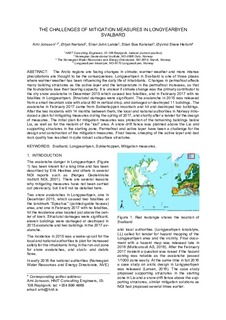The Challenges of Mitigation Measures in Longyearbyen Svalbard
Lecture
Published version
Permanent lenke
http://hdl.handle.net/11250/2589970Utgivelsesdato
2018Metadata
Vis full innførselSamlinger
- NGI articles [1061]
Originalversjon
http://arc.lib.montana.edu/snow-science/item/2517Sammendrag
The Arctic regions are facing changes in climate; warmer weather and more intense precipitations are thought to be the consequences. Longyearbyen in Svalbard is one of those places where warmer weather has been influencing the daily life of inhabitants. Changes in permafrost affects many building structures as the active layer and the temperature in the permafrost increases, so that the foundations lose their bearing capacity. It is unclear if climate change was the primary contributor to the dry snow avalanche in December 2015 which caused two fatalities, and in February 2017 with no fatalities in Longyearbyen. Structural damages were significant. The avalanche in 2015 was released from a small mountain side with about 80 m vertical drop, and damaged or destroyed 11 buildings. The avalanche in February 2017 came from Sukkertoppen mountain and hit and destroyed two buildings. After the two incidents with 14 months between them, the local and national authorities in Norway introduced a plan for mitigating measures during the spring of 2017, and shortly after a tender for the design of measures. The initial plan for mitigation measures was protection of the remaining buildings below Lia, as well as for the reclaim of the "lost" area. A snow drift fence was planned above the Lia and supporting structures in the starting zone. Permafrost and active layer have been a challenge for the design and construction of the mitigation measures. Frost heave, creeping of the active layer and bad rock quality has resulted in quite robust subsurface structures.
